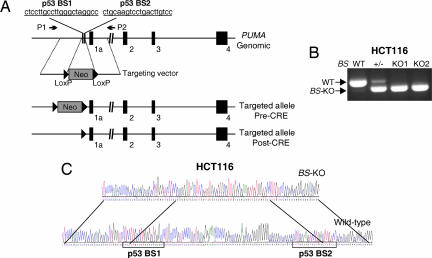Fig. 1.
Targeted deletion of the p53-binding sites in the PUMA promoter in HCT116 cells. (A) PUMA genomic locus and the targeting construct. The targeting construct consists of two homologous arms and the neomycin-resistance gene (Neo). Boxes 1a–4 represented exons 1a–4 of PUMA. Homologous recombination resulted in a deletion of 92 base pairs, including a part of both p53-binding sites (p53 BS1 and BS2). The same construct was used in the second round of gene targeting after the Neo, flanked by two LoxP sites, was excised from the heterozygous cells by Cre recombinase. The positions of the primers (P1 and P2) for PCR screening were indicated. (B) Identifying BS-KO clones. PCR was used to analyze HCT116 clones with different p53-binding site (BS) genotypes after removal of Neo. WT and the recombinant (BS-KO) alleles were indicated. (C) DNA sequences of the genomic region containing the p53-binding sites in the parental and BS-KO HCT116 cells. PCR and subsequent sequencing were performed after Neo was excised from both alleles. Two p53-binding sites and overlapping sequences between the WT and BS-KO alleles were indicated.

